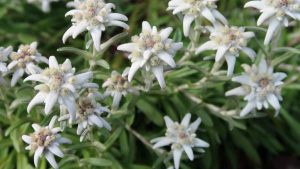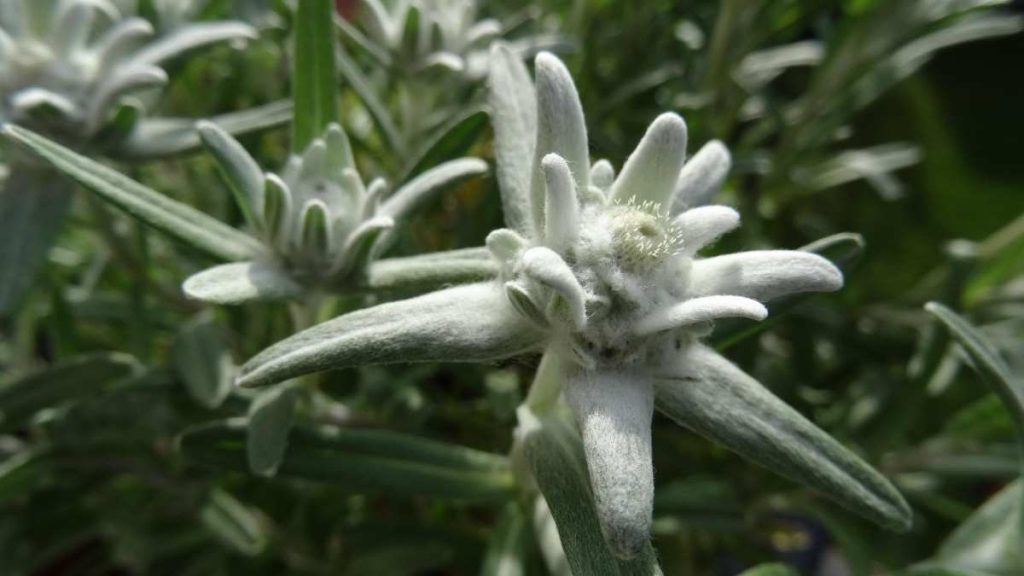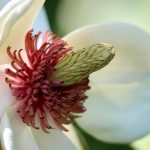Edelweiss Flower (Leontopodium alpinum) is the tiny, star-shaped bloom that has come to symbolize the high Alps rare, rugged, and quietly beautiful. Found on rocky slopes and alpine meadows, its woolly white petals and low, cushion-like habit help it survive wind, cold and intense sun at altitude. Because it grows in hard-to-reach places and appears delicate against a harsh landscape, edelweiss has long been linked with purity, courage, and the romance of mountain life.
In this article we’ll treat edelweiss as both a botanical marvel and a cultural icon: you’ll learn how it evolved to live where few plants can, why it captured so many folk stories and songs, and what conservation efforts protect it today. I’ll also outline practical notes for readers curious about spotting or cultivating related species so the sections that follow will flow together into one clear guide to the flower’s history, science, symbolism, and care.
Why is this flower so legendary?
The Edelweiss flower holds a place in Alpine folklore that few plants can rival. On the surface, it’s a small, star-shaped bloom modest compared to showy roses or lilies but its power lies in where and how it grows. High in the rugged Alps, where jagged peaks pierce the sky and icy winds sweep across narrow ridges, edelweiss clings to rocky ledges at altitudes between 1,800 and 3,000 meters. It thrives in places so inaccessible that reaching it often demands skill, stamina, and courage.
For centuries, this difficulty in finding it has shaped its reputation. In traditional Alpine courtship, young men would risk their lives scaling cliffs to bring an edelweiss to the women they loved. To offer one was more than a romantic gesture it was proof of bravery and devotion. This connection to love and daring found its way into songs, poetry, and even military symbolism. In 19th-century Europe, it became a badge of honor for soldiers and mountaineers, representing loyalty, perseverance, and the unbreakable bond with the rugged beauty of the mountains.
Culturally, the Edelweiss became a living emblem of the Alps themselves. Its woolly, silver-white petals protect it from frost and harsh UV rays, almost like nature’s armor making it both delicate in beauty and fierce in resilience. This combination of fragility and strength is what keeps it legendary. Even today, spotting one in the wild feels like discovering a secret gift from the mountains, a reminder that the rarest treasures often lie in the most challenging places.

The Myth and Legend of Edelweiss
Few flowers carry as much romantic weight in folklore as the Edelweiss Flower. In Alpine legend, it is often described as the “flower of true love.” One of the most enduring tales tells of young men risking their lives to climb treacherous peaks just to pick a single bloom for the woman they loved a gesture that proved both bravery and devotion. Because the flower grows in remote, high-altitude areas, such a gift wasn’t just rare; it was a testament of courage and sacrifice.
In other stories, the Edelweiss Flower is a symbol of purity and divine blessing. The flower’s star-like shape and soft, white petals evoked images of celestial light, inspiring the belief that it was a token from the heavens to the earth. These ideas were strengthened by the flower’s association with untouched, pristine alpine landscapes places where nature still reigns unspoiled.
By the late 19th and early 20th centuries, the Edelweiss Flower began to transcend folklore and take on national significance. It became a proud emblem for Austria, Switzerland, and parts of Germany, appearing on coins, traditional costumes, and even military insignia. For alpine climbers and adventurers, it became a badge of achievement proof that they had braved the mountains’ most challenging heights. Over time, the Edelweiss evolved from a wild mountain bloom into a cultural icon, representing the heart and spirit of the Alps.
Botanical Characteristics
The Edelweiss, scientifically known as Leontopodium alpinum, belongs to the Asteraceae family the same family as daisies and sunflowers. Despite its delicate beauty, this hardy perennial plant thrives in some of Europe’s most extreme environments, perfectly adapting to life there.
People instantly recognize its appearance: clusters of small yellow florets surrounded by five to fifteen woolly, star-shaped bracts that many mistake for petals. Fine white hairs cover these bracts, giving the flower its iconic snow-dusted look. This star-like formation is not only visually striking but also symbolic, often representing purity and resilience in Alpine culture.
Edelweiss thrives in high-altitude habitats, usually between 1,500 and 3,000 meters above sea level. It grows on rocky slopes and limestone outcrops, where few other plants can survive. Its adaptations are nothing short of remarkable those dense, hairy leaves and bracts protect it from intense ultraviolet radiation, reduce water loss in dry mountain air, and provide insulation against freezing temperatures. In short, every aspect of its structure is nature’s way of crafting a flower that can stand proudly where the air is thin, the sun is fierce, and the winters are long.
Cultural and Historical Significance
The Edelweiss holds a deep cultural and historical resonance that stretches far beyond its beauty. Traditional Alpine healers valued it for its medicinal properties, particularly for treating respiratory ailments like coughs and bronchitis. Local healers would often steep its leaves and flowers into teas or tinctures, believing its mountain-born purity carried healing strength.
Its symbolism also took root in military history. The Edelweiss became the emblem of elite mountain troops, most famously the German Gebirgsjäger during World War II. Soldiers operating in the harsh Alpine terrain wore the flower—whether real or embroidered as a badgeas a mark of courage and endura nce, essential qualities for their survival. This association with bravery only deepened its legendary status.
In popular culture, the Edelweiss achieved worldwide recognition through music most notably in the beloved song “Edelweiss” from The Sound of Music. While the song was fictional in origin, it tapped into the flower’s symbolism of homeland pride, love, and the bittersweet beauty of fleeting moments. Through these many roles healer, military emblem, patriotic symbol, and artistic muse the Edelweiss has become more than just a flower. It is a living emblem of resilience, purity, and the spirit of the Alps. Its image adorns coins, stamps, and souvenirs, while its story is passed down in songs, poems, and family traditions. Even today, seeing Edelweiss in the wild stirs a quiet sense of wonder, connecting people to centuries of history and the rugged, untamed beauty of the mountains it calls home.
Experiencing Edelweiss in the Alps
Spotting Edelweiss in the wild is one of the most magical experiences the Alps can offer. These rare blooms are found in some of the most breathtaking and often remote locations. In the Swiss Alps, the Jungfrau region and the slopes near Zermatt are prime spots, offering scenic hikes with the possibility of a sighting. The Dolomites in northern Italy are another treasure, with rugged limestone cliffs where Edelweiss grows naturally. In the Bavarian Alps of Germany, you might discover them above the treeline on steep, rocky paths, often between 1,500 and 3,000 meters in altitude. The challenge of reaching these places makes the encounter even more special.
When you do find Edelweiss, remember that they are a protected species. Picking them is illegal in many Alpine countries, and even light handling can harm their delicate structure. Ethical observation means keeping a respectful distance, staying on marked trails, and resisting the temptation to take a bloom home. The true value lies in the memory and perhaps a photo of your discovery.
If mountain climbing isn’t an option, you can still enjoy the charm of Edelweiss in other ways. Many Alpine towns celebrate the flower through local crafts, embroidery, jewelry, and carved souvenirs. Some artisans weave it into traditional hats or create porcelain keepsakes that capture its beauty. Festivals often feature Edelweiss motifs in costumes, decorations, and music, allowing you to immerse yourself in its cultural significance without disturbing its natural habitat. You might even encounter regional liqueurs, teas, or herbal remedies infused with Edelweiss essence giving you a taste of the Alps’ most beloved bloom.
Used in Cosmetics and Herbal Remedies Today
Edelweiss Flower has stepped gracefully from Alpine slopes into the world of modern wellness and beauty. Thanks to its exceptionally high antioxidant content, this delicate flower is now a star ingredient in many premium skincare products. The compounds in Edelweiss particularly leontopodic acid fight free radicals, protect skin from UV damage, and reduce inflammation. Luxury brands often highlight Edelweiss extract in anti-aging creams, serums, and sunscreens, praising its ability to shield skin from environmental stress while maintaining hydration. It’s a perfect example of nature’s resilience being harnessed for everyday care.
Beyond cosmetics, Edelweiss continues to hold value in herbal Beyond cosmetics, Edelweiss continues to hold value in herbal remedies, particularly in Alpine folk medicine traditions. Historically, people brewed it into teas or tinctures to soothe respiratory ailments, ease abdominal discomfort, and strengthen the immune system. While modern medicine has replaced many of these uses with pharmaceuticals, herbalists and natural health enthusiasts still appreciate Edelweiss for its anti-inflammatory and antimicrobial properties.
Today, manufacturers often blend its extracts into herbal supplements and market them for skin health, vitality, and stress relief. However, because protections safeguard the wild plant, these products typically rely on sustainably cultivated Edelweiss grown in controlled Alpine gardens. This approach ensures people can share the flower’s magic without endangering its fragile wild populations a beautiful balance between tradition and conservation.
Conclusion: The Timeless Charm of Edelweiss
The Edelweiss flower stands as a rare blend of beauty, symbolism, and resilience. Its soft, star-shaped petals tell a story that stretches from romantic Alpine legends to its role in cultural history, music, and even modern wellness. To see Edelweiss in bloom often clinging to the rugged edges of high mountain slopes is to witness a living symbol of purity, bravery, and love.
Even in today’s fast-paced world, Edelweiss remains an enduring emblem of the Alps, treasured not just for its appearance, but for what it represents: the harmony between fragility and strength, and the magic of nature’s most remote corners.
If you ever find yourself in the Alps, take a moment to look for this elusive bloom. Observe it, don’t pluck it let it remain where it thrives, inspiring others for generations to come. By supporting sustainable tourism and conservation efforts, we ensure that Edelweiss will continue to grace the Alpine landscape, reminding us that some treasures are worth protecting forever.
FAQs About the Edelweiss Flower
Q1: Is Edelweiss really rare?
Yes, Edelweiss is considered rare in the wild because it thrives only in specific high-altitude Alpine regions. Past over-picking and its fragile habitat have led to strict protections in many countries.
Q2: Can you grow Edelweiss at home?
Yes, but it’s a challenge. Edelweiss prefers well-drained, rocky soil, full sunlight, and cool temperatures—conditions similar to its natural Alpine environment.
Q3: What does the Edelweiss flower symbolize?
Edelweiss symbolizes love, bravery, purity, and devotion. In folklore, it was often gifted as a token of deep affection, as finding it meant braving dangerous mountain climbs.
Q4: Why is Edelweiss protected?
Over the years, heavy tourist interest and romantic traditions led to over-harvesting. To preserve its natural populations, most Alpine countries have made picking wild Edelweiss illegal.
Q5: Where can I see Edelweiss in the wild?
You can spot Edelweiss in the Swiss Alps, the Dolomites in Italy, and the Bavarian Alps in Germany often along marked trails and nature reserves.
Q6: Is Edelweiss used in products today?
Yes. Its antioxidant and anti-aging properties make it popular in cosmetics and skincare products. It’s also used in some herbal remedies for respiratory health.
Q7: Is Edelweiss related to daisies?
Surprisingly, yes. Edelweiss belongs to the Asteraceae family, which also includes daisies and sunflowers.



